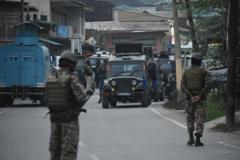In response to a militant attack that killed 26 individuals in Indian-administered Kashmir, India has executed strikes across Pakistan and Pakistan-administered Kashmir, igniting assertions of aggression and counterclaims from Pakistan. The backdrop involves a history of violence and geopolitical strategic challenges as both nations remain embroiled in conflict over Kashmir.
Escalating Tensions: India's Military Strikes on Pakistan in Wake of Deadly Kashmir Attack

Escalating Tensions: India's Military Strikes on Pakistan in Wake of Deadly Kashmir Attack
Following a tragic assault on tourists in Kashmir, India launched "Operation Sindoor" targeting Pakistan, escalating long-standing regional tensions.
In the aftermath of a terror attack that resulted in the deaths of 26 individuals in Indian-administered Kashmir, India's military action has intensified against Pakistan and Pakistan-administered Kashmir. Code-named "Operation Sindoor," these strikes are a response to what India states was a deliberate targeting of its citizens on 22 April, leading to an intense cycle of retaliatory actions from both sides.
The Indian defence ministry asserts that the operation was driven by a commitment to hold accountable those responsible for the attack, which claimed the lives of 25 Indians and one Nepali national. However, Pakistan has swiftly countered these claims, labeling the strikes as "unprovoked" and asserting that they will not go unanswered. Prime Minister Shehbaz Sharif condemned the actions, declaring that they represent a "heinous act of aggression."
As tensions mounted, Pakistan’s military reported downing five Indian aircraft and a drone, claiming that the strikes had inflicted civilian casualties, with eight reported dead. Meanwhile, India has reported three civilian casualties from Pakistani-generated shelling in its territories.
According to official statements from India, multiple sites deemed "terrorist infrastructure" were targeted during the strikes. Efforts were reportedly aimed at avoiding any military installations to prevent escalation. Contrarily, Pakistan rejected these assertions, claiming that the strikes targeted civilian areas rather than militant camps.
The backdrop of this military engagement is predicated on decades of conflict over Kashmir. The disputed region has witnessed prolonged unrest since the partition of British India in 1947. The recent attack is the most severe on civilians in twenty years and has reignited a long-simmering conflict exacerbated by historical grievances.
India's Prime Minister Narendra Modi publicly vowed to pursue the suspected perpetrators relentlessly, yet no specific group has been officially linked to the Pahalgam attack. Two presumed attackers have been identified as Pakistani nationals, leading India to reaffirm its accusations of Pakistan harboring militant groups, a claim that Islamabad vehemently denies.
In the weeks following the initial attack, diplomatic deteriorations unfolded, with both nations expelling diplomats and tightening cross-border restrictions. A widely anticipated escalation seemed imminent, reminiscent of the reactions observed after earlier significant attacks in the region.
The geopolitical climate has created a complexity around Kashmir, with the international community keenly observing the situation. Calls for restraint have emerged from various global leaders, underscoring the potential risks of a broader conflict between the two nuclear-armed neighbors. As both sides navigate this fraught atmosphere, the specter of violence lingers, questioning the future of peace in a historically contentious region.























